16 Best Exercises for Women Over 50 To Live Longer
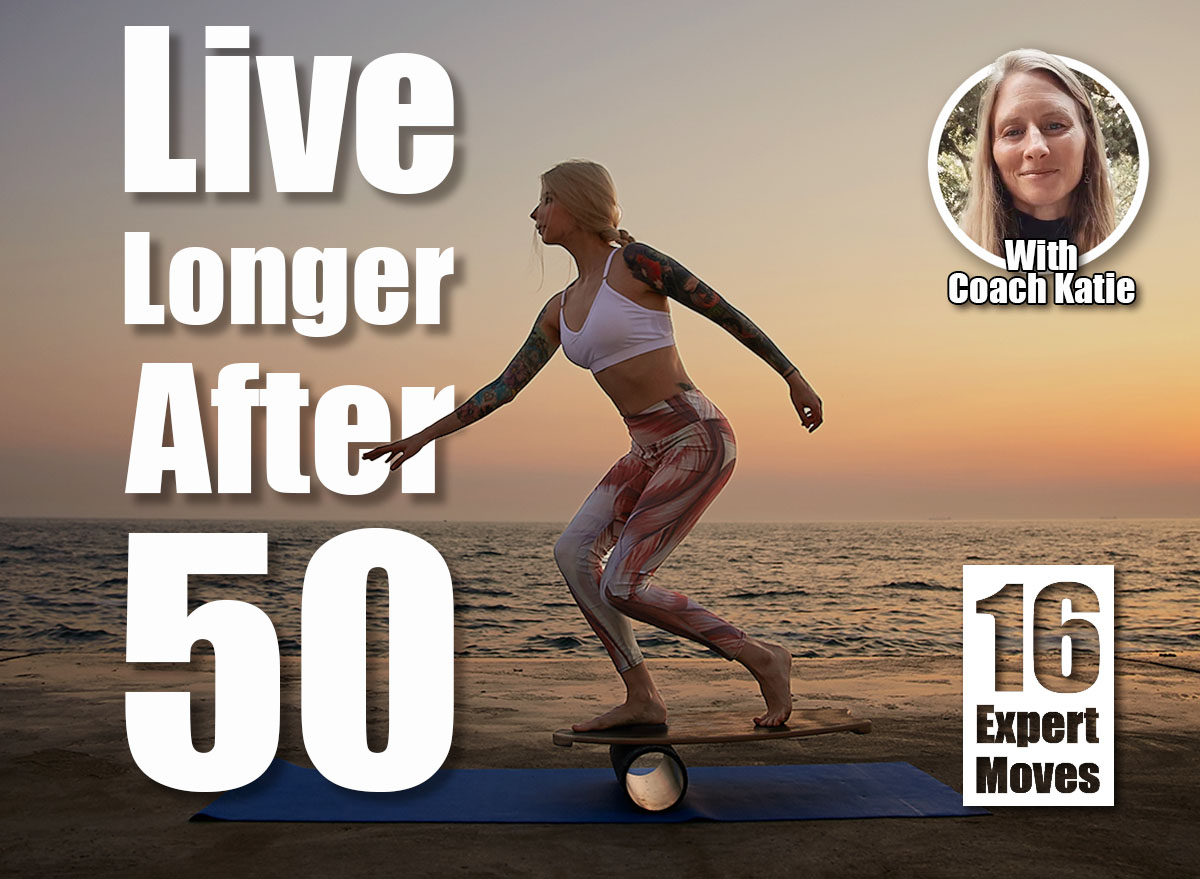
Hitting the half-century mark is much more than a milestone birthday—it’s a testament to your resilience, wisdom, and perseverance. At the same time, this brand-new stage of life brings on many changes—some more challenging to accept than others. Metabolism slows, muscle mass naturally declines, and belly fat tends to accumulate in the midsection more easily than it used to—ugh. Giving your body a dose of daily exercise is one of the smartest things you can do to stay strong, fit, and resilient. That’s why we learned the best exercises for women over 50 to live longer. The best part? They can easily be integrated into your routine.
Why Regular Exercise Is Crucial for Women Over 50
During perimenopause and menopause, hormones decline. That means you no longer naturally maintain muscle—you actively battle to preserve it, says Katie Armstrong, women’s health and longevity coach, host of LIVIN’ Lab, and founder of Inspired Living by Katie Armstrong.
“In this phase of life, strength training isn’t optional; it’s essential,” Armstrong stresses. “Muscle is the organ of longevity. It impacts insulin sensitivity, bone density, metabolic function, and even brain health. Without strategic effort, the aging process accelerates. Every decade after 40, we lose muscle unless we actively build it. The good news? You can reclaim your health by training smarter, earlier.”
According to Armstrong, everything she recommends for women over 50, she tells clients 40+ to start working on now.
“The earlier you adapt, the easier it is,” she says. “Building muscle before the major hormonal drops makes a huge difference in healthspan and energy. You want to train now for the body you’ll have post-menopause—resilient, strong, and adaptable.”
16 Best Exercises for Women Over 50 To Live Longer
Lunges
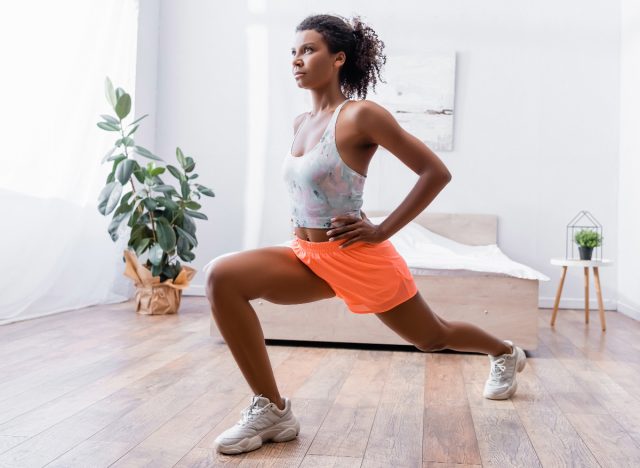
- Stand tall, feet parallel and hip-distance apart.
- Place your hands on your hips.
- Step one foot forward.
- Engage your core as you bend your knees, lowering to form 90-degree bends in both legs.
- Keep your upper body straight.
- Press through your front heel and the ball of your back foot to rise back up.
- Complete 3 sets of 8 to 15 reps per leg.
Romanian Deadlifts
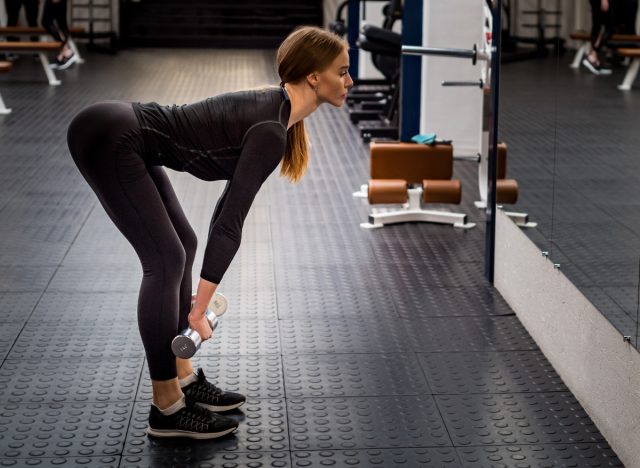
- Stand tall, feet hip-width apart, holding a dumbbell in each hand.
- Bend your knees slightly and hold the weights in front of your thighs.
- Press your hips back as you lower the dumbbells down your leg. Maintain a straight back as you do so.
- Squeeze your glutes to return to the start position.
- Complete 3 to 4 sets of 8 to 15 reps.
Pushups
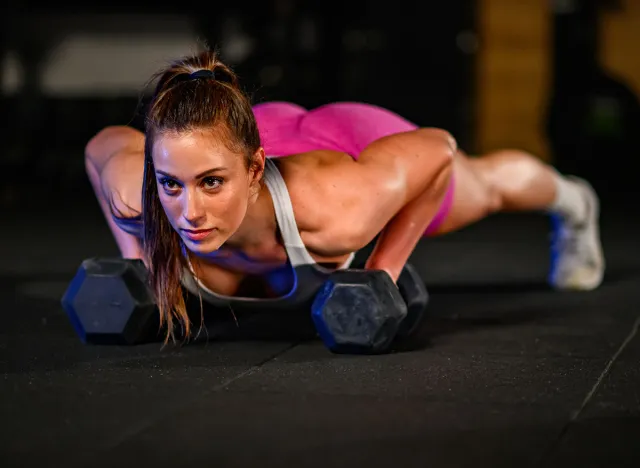
- Start with a high plank with hands under your shoulders and your body straight.
- Bend your elbows and lower your chest toward the floor.
- Maintain a long, straight body as you lower.
- Press back up, straightening your arms.
- Complete 3 sets of 8 to 12 reps.
Side Plank

- Sit side facing, placing one hand on the floor under your shoulder.
- Extend your legs and stack your feet.
- Lift your hips off the floor and activate your core.
- Complete 2 to 3 sets of 30 to 60-second holds per side.
Dumbbell Row
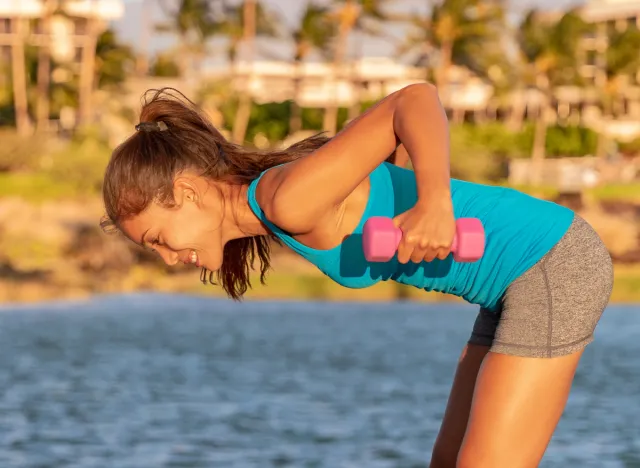
- Stand tall, feet hip-width apart and a dumbbell in each hand in front of you.
- Hinge at the hips until your torso is parallel to the ground.
- Maintain a flat back and soft knees.
- Allow the weights to lower with your arms completely extended.
- Row the dumbbells up toward your torso.
- Lower to the start position with control.
- Perform 3 sets of 8 to 12 reps.
Pull-ups
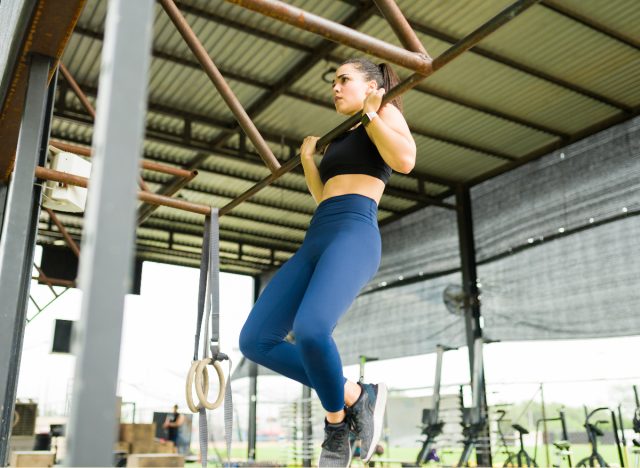
- Stand tall and grab onto a pull-up bar using an overhand grip, hands shoulder-distance apart.
- Hang onto the bar with fully extended arms.
- Pull your chest up toward the bar by bringing your elbows down and back.
- Slowly lower back to the start position.
- Do 3 sets of 8 to 12 reps.
Dumbbell Lying Svend Press
It might sound technical, but once you get the hang of it, the Svend press can be vital for maintaining upper-body strength.
“The Svend press is an excellent chest exercise to add to your chest workout, especially after completing some bench presses and flyers,” explains. Rachel MacPherson, ACE-certified personal trainer with Garage Gym Reviews. “It can improve shoulder joint health by strengthening surrounding musculature and tendons, and it’s joint-friendly, so you can use it to add volume to your training when your joints, triceps, and shoulders begin to fatigue.”
- Lie on a bench, holding two dumbbells in the middle of your chest.
- Press the dumbbells into each other.
- Keep pressure, and extend your elbows to raise the dumbbells above your chest.
- Don’t lock out to maintain the tension, then reverse the motion.
- Drive your feet into the ground for support.
- Perform 3 sets of 10 to 15 reps.
Deep Squats
Squats are a go-to exercise for leg and glute strength. When done correctly, deep squats can improve flexibility and engage multiple muscle groups, ensuring your lower body remains strong and agile.
“In many countries, squatting multiple times per day is commonplace,” says MacPherson. “Women in these countries can easily squat to the ground without any pain or dysfunction and, as a result, have excellent mobility in their hips, spine, knees, and ankles. While you don’t necessarily have to squat with weights, a deep yogic squat or a simple bodyweight squat will help improve your mobility and stability for less likelihood of pain and muscle dysfunction.”
- Hinge your hips and bend your knees to lower your torso toward the floor.
- Keep your chest up high and your back as straight as you can.
- If you can manage a deep squat, try placing your elbows inside your knees and pressing your hands together to push your knees apart further and deepen the stretch.
- Hold here, and breathe for a few breaths before standing.
- Do 3 sets of 60-second holds.
Incline Pushups
If traditional pushups feel challenging, incline pushups are an excellent alternative.
“Pushups help build chest, core, and arm strength, which can be lacking in women but is vital for protecting the spine, neck, and shoulders from pain and injury and improving daily functioning,” explains MacPherson. “Perform a pushup with your upper body leaning against a steady, elevated surface, such as a weight bench or sofa. The higher the incline, the easier the exercise will be.”
- Place your hands wider than chest-width apart, with your chest aligned with the edge of the elevated surface.
- Slowly lower yourself toward it by bending your elbows, which should be pointing diagonally behind and away from you.
- Lower until your chest touches the surface, then press back up.
- Complete 2 to 3 sets of as many reps as possible.
Pickleball
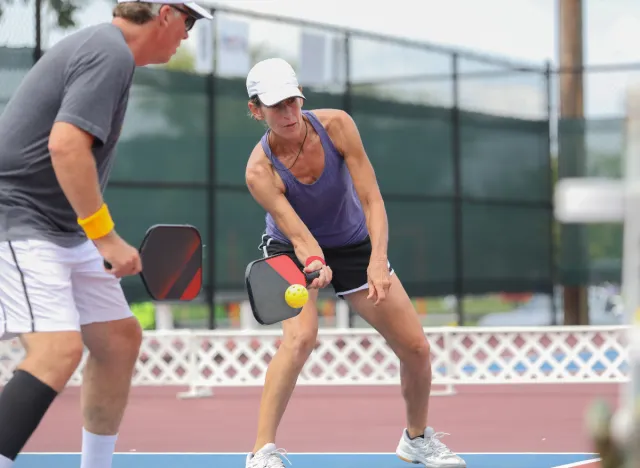
People are buzzing about pickleball—for good reason. This invigorating paddle sport blends tennis, badminton, and ping-pong elements, making it perfect for those wanting to mix cardio with social interaction. Not only does pickleball keep you moving, but research shows it can also boost your mental health.
“Pickleball is one of the fastest-growing sports today, especially among older adults,” states MacPherson. “It’s the perfect sport for older people because it combines socializing with exercise, which is more challenging to come by as you age. Pickleball can provide a social outlet while helping prevent health concerns such as arthritis, stroke, type 2 diabetes, heart disease, and dementia.”
Dance
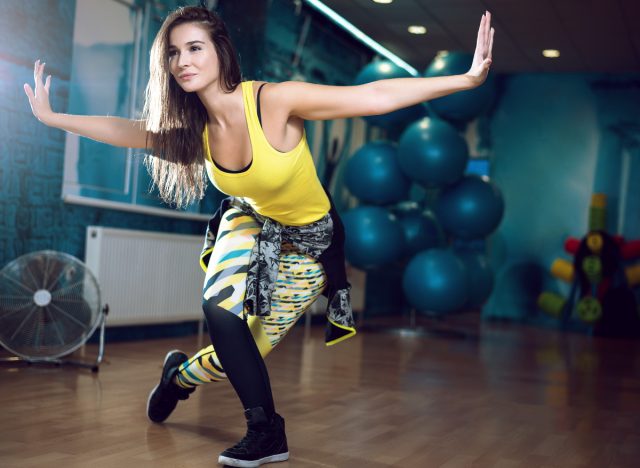
Whether swaying to ballroom tunes or getting your groove on with Zumba, dancing isn’t just fun; research shows it’s fantastic for mental health, cardiovascular fitness, and musculoskeletal strength.
“Dance classes are a fun way to socialize or bond with your partner (or meet someone new) while improving balance and coordination, two aspects of fitness that are crucial for aging adults,” MacPherson points out. “Falls are among the most common risks that grow as you age and are the biggest culprit of fractures that lead to loss of independence and declining health. Dancing can also be a fantastic cardiovascular workout, improving heart health and protecting against cardiovascular disease, type 2 diabetes, stroke, and dementia, among other health concerns.”
Walking Clubs

There’s something refreshing about lacing up your shoes and going on a good old-fashioned walk. Joining a walking club ensures you get your steps in while enjoying good company. Research shows that walking promotes healthy aging by reducing your risk of cardiovascular disease, type 2 diabetes, and dementia while enhancing your sleep, mental well-being, and longevity.
“Walking is an accessible form of exercise that everyone should do daily,” explains MacPherson. “Walking improves mental well-being, blood pressure, and blood sugar levels and helps increase daily activity levels, leading to overall calorie and weight balance. Walking as a group in a class or with a club can provide motivation and socialization, which are aspects of older adults’ fitness regimens that shouldn’t be overlooked for their importance.”
Yoga
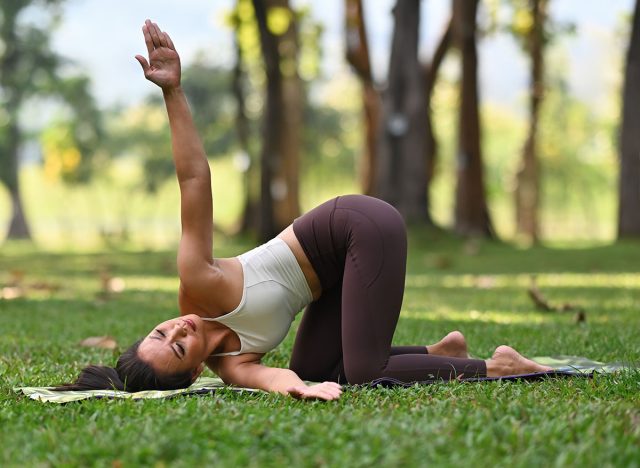
Beyond its well-documented benefits for flexibility and mental well-being, yoga is excellent for muscle toning and strength. Multiple studies show that yoga benefits balance, mental health, mobility, and cellular aging—all critical aspects of healthy aging.
“Gentle yoga classes are perfect for older adults who have trouble with more vigorous forms of exercise or want to add more relaxing and easy movement into their existing exercise routine,” MacPherson tells us. “Yoga is a low-impact form of exercise that can boost joint health and help prevent falls.”
Resistance Band Strength Training

Resistance bands are the unsung heroes of home workouts. They’re adaptable, easy to store, and fantastic for strength training. According to a 2022 study, resistance bands can keep your muscles firm and functional as your muscles naturally lose mass with age.
“Every older adult should do some form of resistance training,” advises MacPherson. “Resistance bands or basic strength training helps prevent bone loss and can even increase it. Bone loss is a major issue for aging women, especially after menopause, when changing hormones leads to lower estrogen, which lowers bone mass. Resistance training helps prevent this from happening.”
Water Aerobics
Engaging in water aerobics can improve cardiovascular health and muscle tone while protecting your joint health—a win-win for those over 50. Plus, water exercise has been associated with decreased pain for individuals with arthritis.
MacPherson tells us, “Water aerobics is a classic exercise class for seniors since it’s low-impact, joint-friendly, and social. It can provide cardiovascular and strength training, improve heart health, endurance, and cognition, and prevent disease and illness. Water aerobics can positively impact functional fitness and body composition, which are both protective against loss of independence and all-cause mortality.”
Balance Training
Stability might not sound as glamorous as strength or speed, but it’s vital for preventing falls and maintaining independence as you age. Simple exercises, like standing on one leg or using a balance board, can work wonders for your core strength and stability.
“Falls are one of the top reasons why older individuals end up in care homes,” says MacPherson. “Falls are also scary and can cause further injury and pain, including hip fractures. It’s wise to include balance and stability training in your routine. Try yoga, tai chi, or specific programs to improve your balance.”
Looking for easy ways to lose fat? Here’s How Long Your Walking Workout Should Be To Shrink Belly Fat.